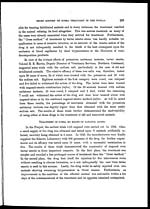Medicine - Veterinary > Veterinary colleges and laboratories > Indian journal of veterinary science and animal husbandry > Volume 4, 1934 > Original articles > Short history of surra treatment in the Punjab
(262) Page 234
Download files
Individual page:
Thumbnail gallery: Grid view | List view

234 THE INDIAN JOURNAL OF VETERINARY SCIENCE AND ANIMAL HUSBANDRY [ IV, III
routine treatment for camel surra, was practised in the case of these animals with
a considerable degree of success by the military authorities both in and outside
India. By arrangement with the military authorities, numerous batches of in-
fected camels were successfully treated at Sohawa by Cross and his assistant
Chaudhri Kahan Singh up to the time of its final adoption by R. A. V. C. officers.
A small amount of preliminary investigational work had been done by Cross
on the efficacy of tartar emetic in the treatment of equines also but amongst
artificially infected cases only.
On Cross's retirement in 1923, there being no Indian Veterinary Service Officer
available, his Assistant Veterinary Inspector Chaudhri Kahan Singh, a graduate
of the Punjab Veterinary College, was placed in charge of the Sohawa Laboratory,
which was then placed as a district charge under the direct supervision of the Chief
Superintendent, Civil Veterinary Department. Henceforward the Sohawa Labora-
tory was to become more closely identified with the needs of the districts. The
time was ripe for pressing on with propaganda amongst camel breeders to bring
their surra cases to veterinary hospitals for treatment. Horse breeding in many
areas of the province was in a very precarious condition about this time owing to
the heavy incidence of surra and the only advice that could be then offered to
breeders was to shoot their sick ponies.
In earlier trials, Kahan Singh had tested the efficacy of the " Cross method "
upon 14 artificial cases of equine surra and obtained what appeared complete
recovery in as many as 13 of these. In view of these unexpectedly satisfactory
results, it was considered desirable to try the same treatment in cases of natural
surra. The Sheikhupura Veterinary Hospital located near the Deg Nullah, the
worst surra zone in the Punjab, was selected for the purpose. Twenty-six ponies
suffering from surra in this locality were subjected to this treatment, but only five
cases were cured. Although these results could not be regarded as very satis-
factory, the form of treatment, nevertheless, gave undoubted promise of success if
carried out under conditions that would ensure adequate feeding arrangements
for the animals during their course of treatment. As a matter of fact, the treat-
ment had to be carried out under considerable disabilities consequent upon a lack
of staff and stabling, whilst the owners themselves, whose previous experience had
shown them the futility of all curative measures against the disease, were not
willing to provide even the feeding for their animals while under treatment. The
District Board, which was approached for funds to supplement the feeding arrange-
ments by owners, would not agree to a policy of spoon feeding. However, in the
surra season of 1924, the value of this method was further tested, under somewhat
better conditions, upon 96 cases of natural surra, all belonging to private owners,
at four different centres in the Punjab, resulting in 49 cures. While these results
were encouraging, the drug was found too irritant and drastic in effect to be suit-
Set display mode to: Large image | Zoom image | Transcription
Images and transcriptions on this page, including medium image downloads, may be used under the Creative Commons Attribution 4.0 International Licence unless otherwise stated. ![]()
| Permanent URL | https://digital.nls.uk/75234502 |
|---|
| Description | Covers articles from 1934. |
|---|




